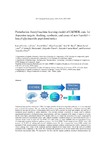Mostrar o rexistro simple do ítem
Perturbation theory/machine learning model of ChEMBL data for dopamine targets: docking, synthesis, and assay of new l-prolyl-l-leucyl-glycinamide peptidomimetics
| dc.contributor.author | Ferreira da Costa, Joana | |
| dc.contributor.author | Silva, David | |
| dc.contributor.author | Caamaño, Olga | |
| dc.contributor.author | Brea, José M. | |
| dc.contributor.author | Loza, María Isabel | |
| dc.contributor.author | Munteanu, Cristian-Robert | |
| dc.contributor.author | Pazos, A. | |
| dc.contributor.author | García-Mera, Xerardo | |
| dc.contributor.author | González-Díaz, Humberto | |
| dc.date.accessioned | 2019-01-11T09:51:49Z | |
| dc.date.available | 2019-01-11T09:51:49Z | |
| dc.date.issued | 2018-05-23 | |
| dc.identifier.citation | Ferreira da Costa J, Silva D, Caamaño O, et al. Perturbation theory/machine learning model of ChEMBL data for dopamine targets: docking, synthesis, and assay of new l-prolyl-l-leucyl-glycinamide peptidomimetics. ACS Chem Beurosci. 2018; 9(11): 2572-2587 | es_ES |
| dc.identifier.issn | 1948-7193 | |
| dc.identifier.uri | http://hdl.handle.net/2183/21563 | |
| dc.description.abstract | [Abstract] Predicting drug–protein interactions (DPIs) for target proteins involved in dopamine pathways is a very important goal in medicinal chemistry. We can tackle this problem using Molecular Docking or Machine Learning (ML) models for one specific protein. Unfortunately, these models fail to account for large and complex big data sets of preclinical assays reported in public databases. This includes multiple conditions of assays, such as different experimental parameters, biological assays, target proteins, cell lines, organism of the target, or organism of assay. On the other hand, perturbation theory (PT) models allow us to predict the properties of a query compound or molecular system in experimental assays with multiple boundary conditions based on a previously known case of reference. In this work, we report the first PTML (PT + ML) study of a large ChEMBL data set of preclinical assays of compounds targeting dopamine pathway proteins. The best PTML model found predicts 50000 cases with accuracy of 70–91% in training and external validation series. We also compared the linear PTML model with alternative PTML models trained with multiple nonlinear methods (artificial neural network (ANN), Random Forest, Deep Learning, etc.). Some of the nonlinear methods outperform the linear model but at the cost of a notable increment of the complexity of the model. We illustrated the practical use of the new model with a proof-of-concept theoretical–experimental study. We reported for the first time the organic synthesis, chemical characterization, and pharmacological assay of a new series of l-prolyl-l-leucyl-glycinamide (PLG) peptidomimetic compounds. In addition, we performed a molecular docking study for some of these compounds with the software Vina AutoDock. The work ends with a PTML model predictive study of the outcomes of the new compounds in a large number of assays. Therefore, this study offers a new computational methodology for predicting the outcome for any compound in new assays. This PTML method focuses on the prediction with a simple linear model of multiple pharmacological parameters (IC50, EC50, Ki, etc.) for compounds in assays involving different cell lines used, organisms of the protein target, or organism of assay for proteins in the dopamine pathway. | es_ES |
| dc.description.sponsorship | Ministerio de Economía y Competitividad; CTQ2016-74881-P | es_ES |
| dc.description.sponsorship | Gobierno Vasco; IT1045-16 | es_ES |
| dc.description.sponsorship | Xunta de Galicia; GPC2014/003 | es_ES |
| dc.description.sponsorship | Xunta de Galicia; CN 2012/069 | es_ES |
| dc.description.sponsorship | Xunta de Galicia; ED431D 2017/16 | es_ES |
| dc.description.sponsorship | Xunta de Galicia; ED431D 2017/23 | es_ES |
| dc.description.sponsorship | Xunta de Galicia; GRC2014/049 | es_ES |
| dc.description.sponsorship | Xunta de Galicia; ED431D 2017/23 | es_ES |
| dc.language.iso | eng | es_ES |
| dc.publisher | American Chemical Society | es_ES |
| dc.relation.uri | http://dx.doi.org/10.1021/acschemneuro.8b00083 | es_ES |
| dc.rights | This document is the unedited author's version of a submitted work that was subsequently accepted for publication in ACS Chemical Neuroscience, copyright © American Chemical Society after peer review. To access the final edited and published work, see ACS publications web page. | es_ES |
| dc.subject | ChEMBL | es_ES |
| dc.subject | Machine learning | es_ES |
| dc.subject | Peptide organic synthesis | es_ES |
| dc.subject | PLG peptidomimetics | es_ES |
| dc.title | Perturbation theory/machine learning model of ChEMBL data for dopamine targets: docking, synthesis, and assay of new l-prolyl-l-leucyl-glycinamide peptidomimetics | es_ES |
| dc.type | info:eu-repo/semantics/article | es_ES |
| dc.rights.access | info:eu-repo/semantics/openAccess | es_ES |
| UDC.journalTitle | ACS Chemical Neuroscience | es_ES |
| UDC.volume | 9 | es_ES |
| UDC.issue | 11 | es_ES |
| UDC.startPage | 2572 | es_ES |
| UDC.endPage | 2587 | es_ES |
Ficheiros no ítem
Este ítem aparece na(s) seguinte(s) colección(s)
-
GI-RNASA - Artigos [196]
-
INIBIC-RNASA-IMEDIR - Artigos [47]








